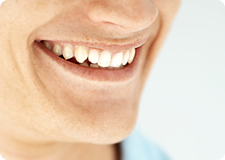Tartar is a deposit that forms when plaque hardens on the tooth. Individuals vary greatly in their susceptibility to tartar buildup. For many, these deposits build up faster with age. Tartar is easily noticeable because of its yellow or brown color on teeth.
What Causes Tartar Buildup
When plaque accumulates and is not removed from teeth, it can harden and turn into tartar. Because tartar buildup bonds strongly to enamel, it can only be removed by a dental professional.
Help Prevent Tartar Buildup
While tartar can only be removed by a dental professional, you can avoid tartar buildup by removing plaque. To help prevent tartar, be sure to brush your teeth at least twice daily, preferably with a tartar-control fluoride toothpaste like many from Crest, and floss once a day with a product like GlideÆ. And visit your dental office regularly for oral exams and cleanings.

















